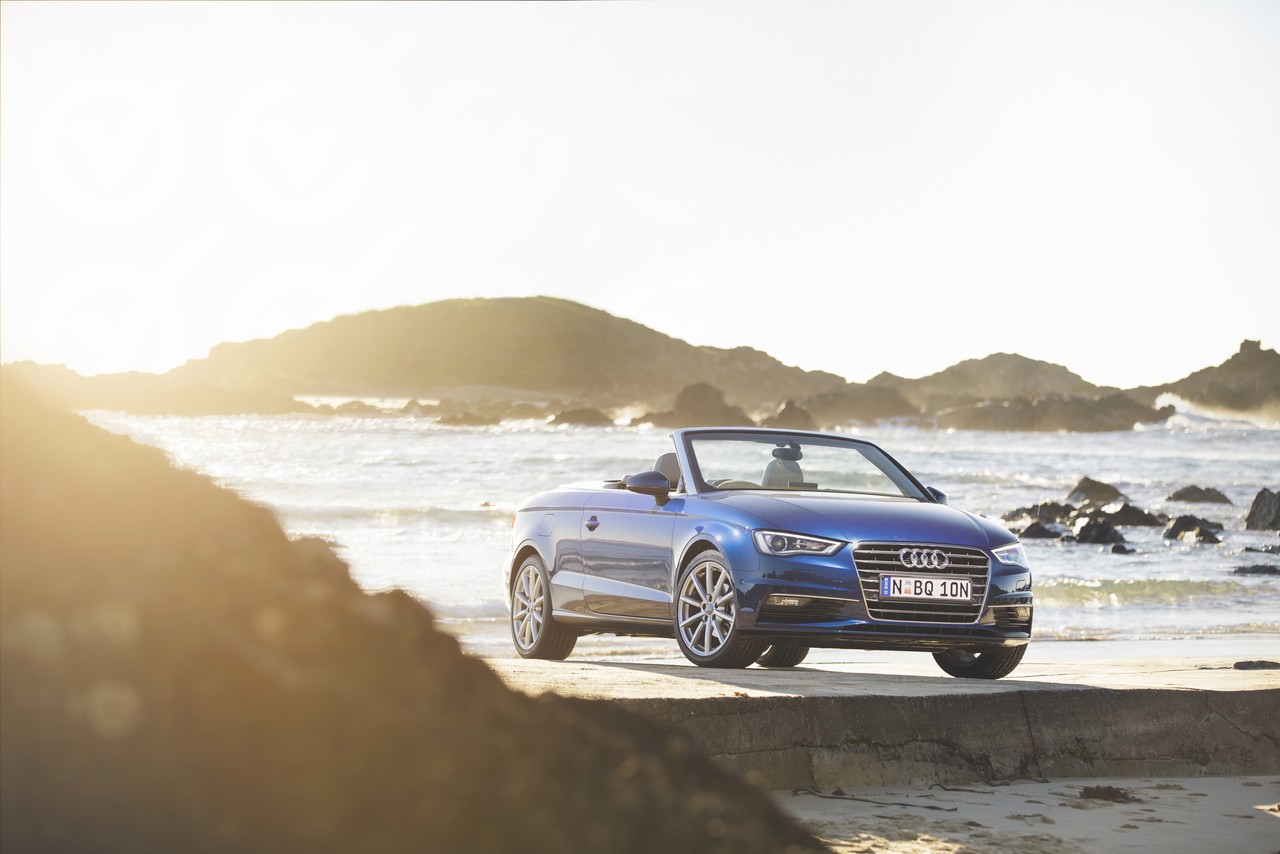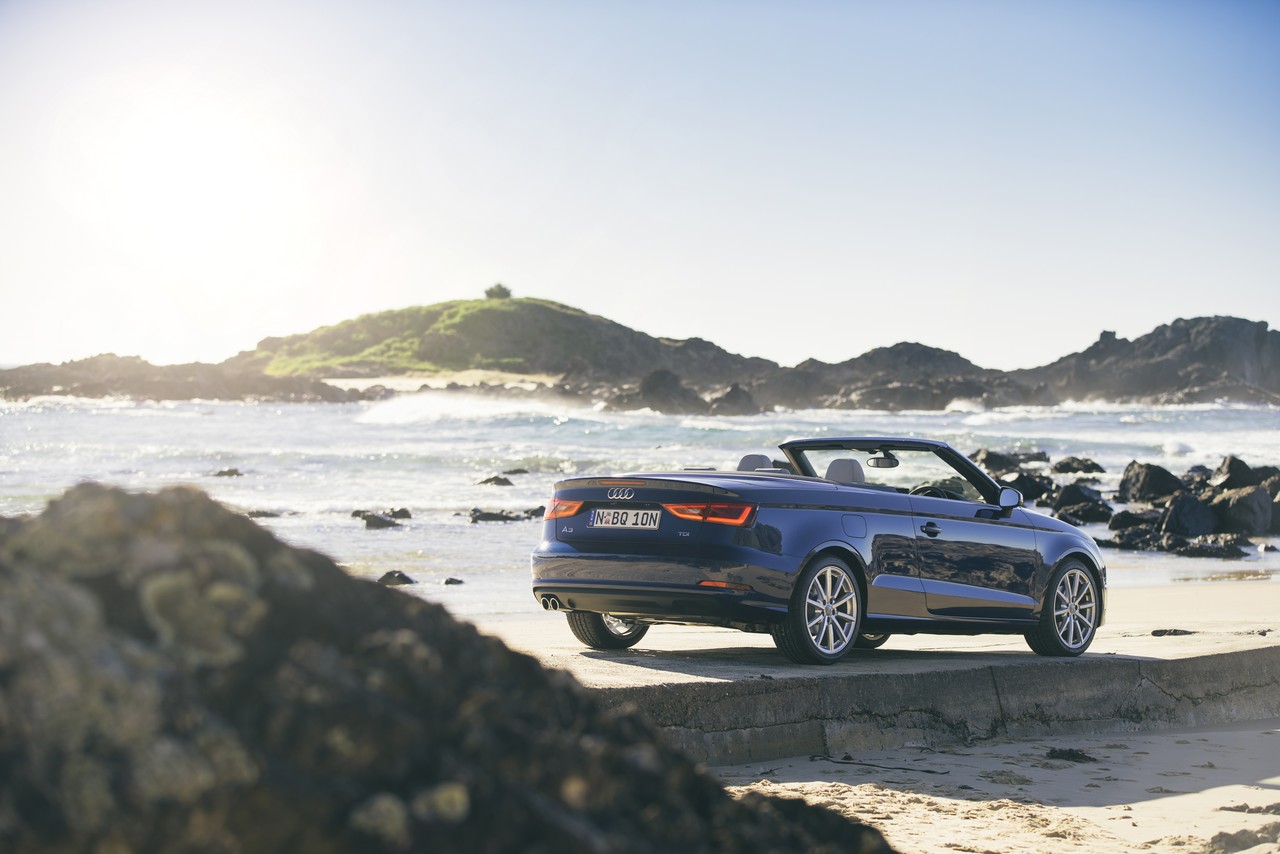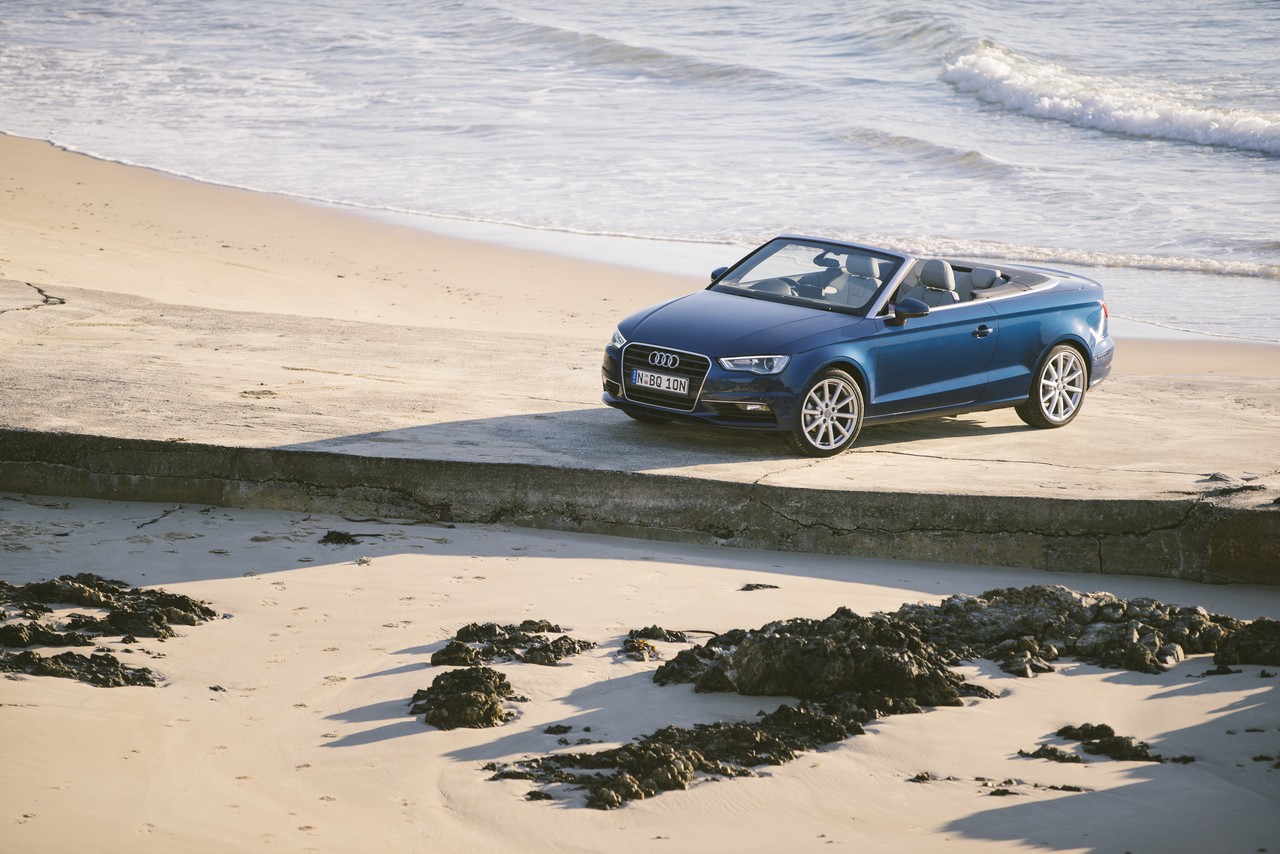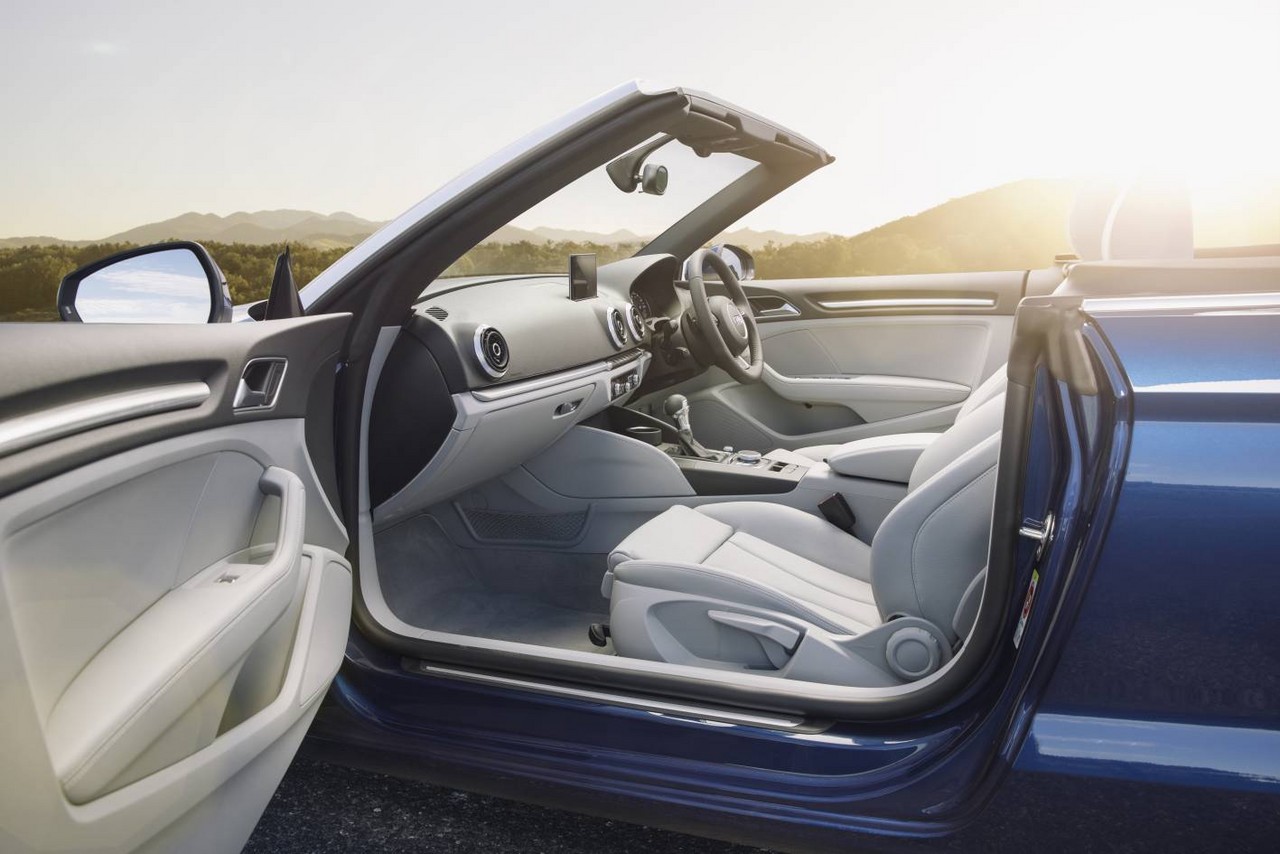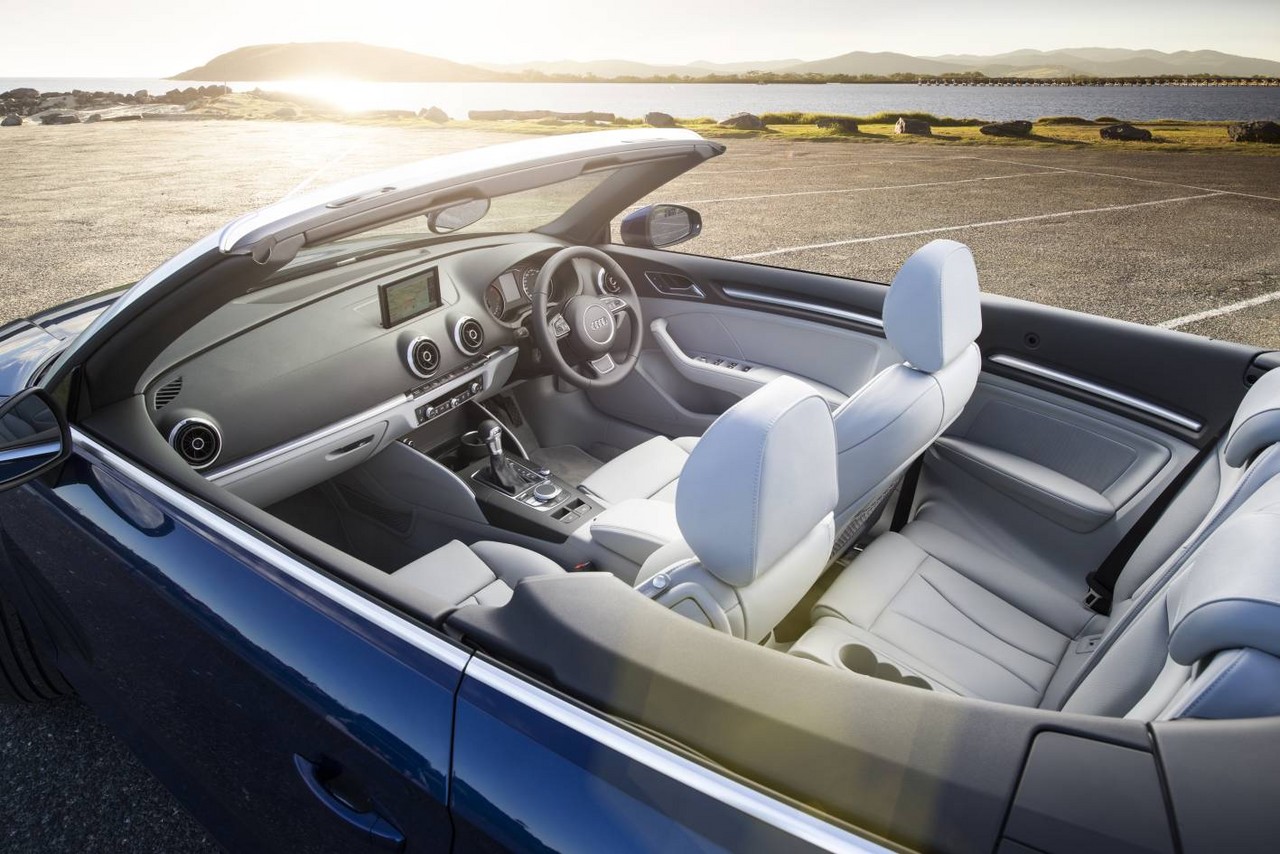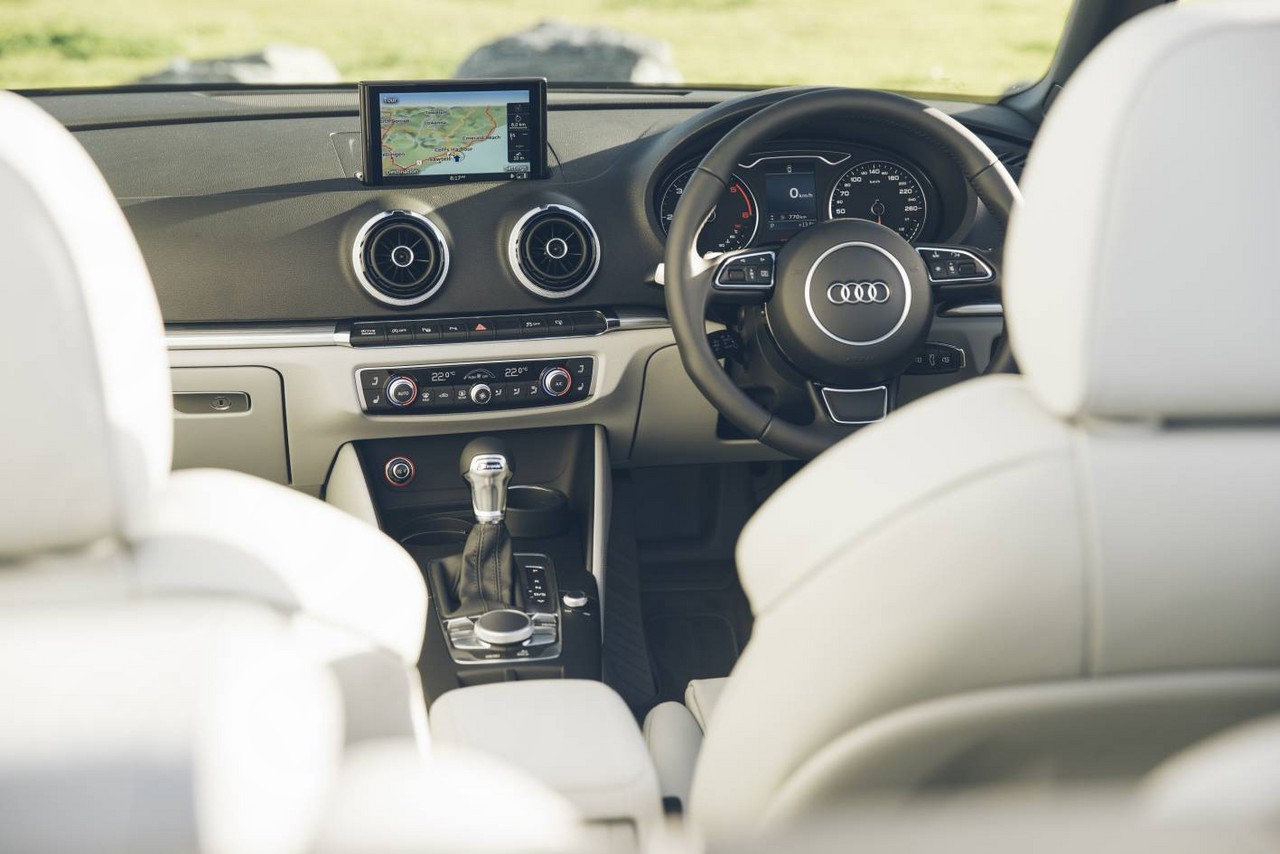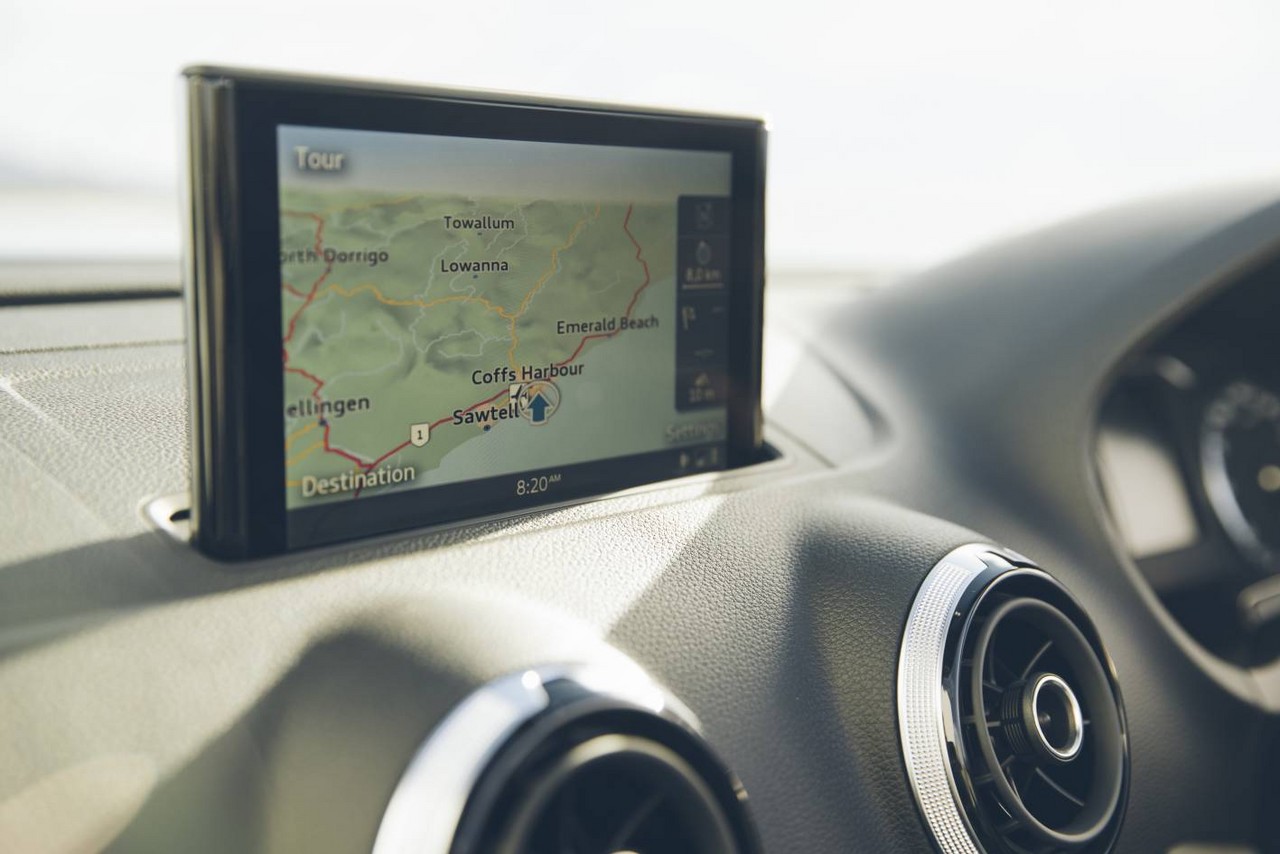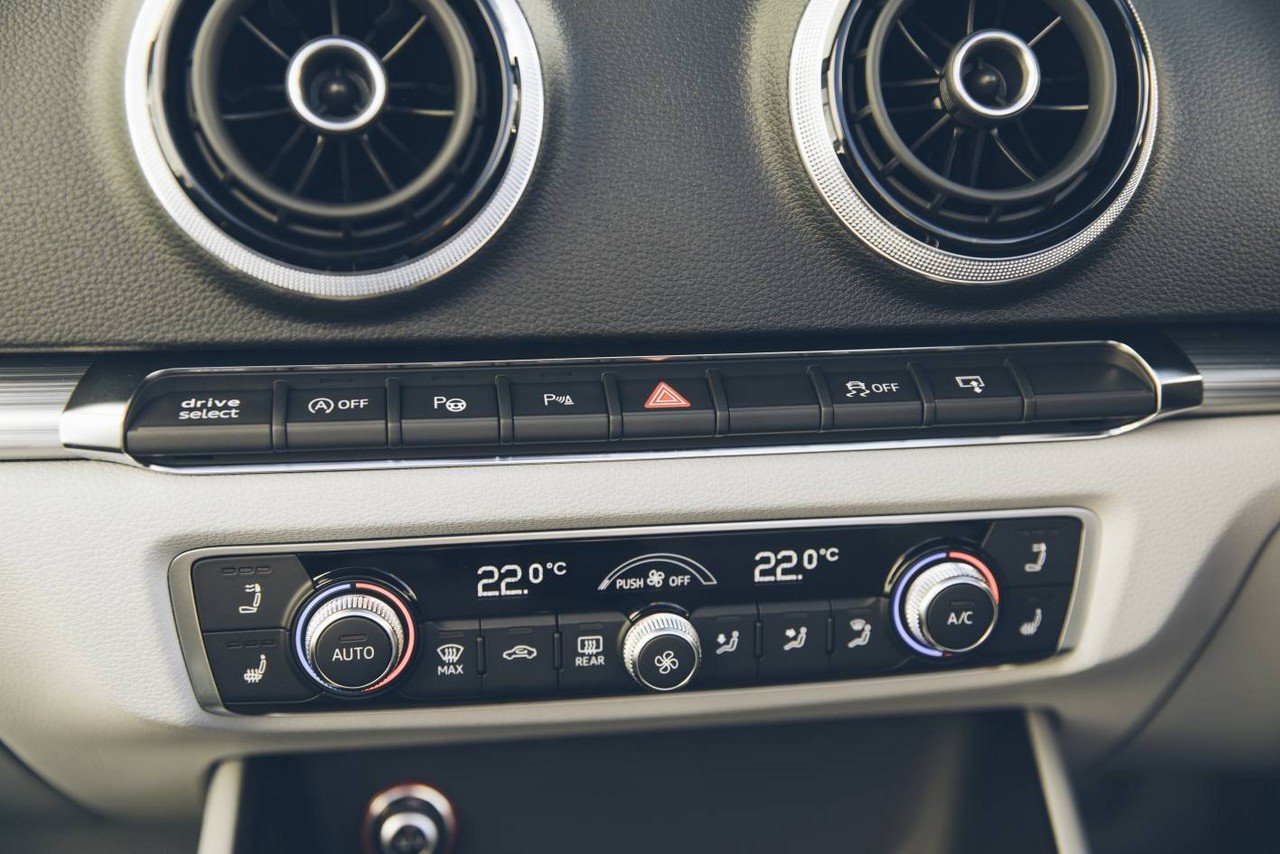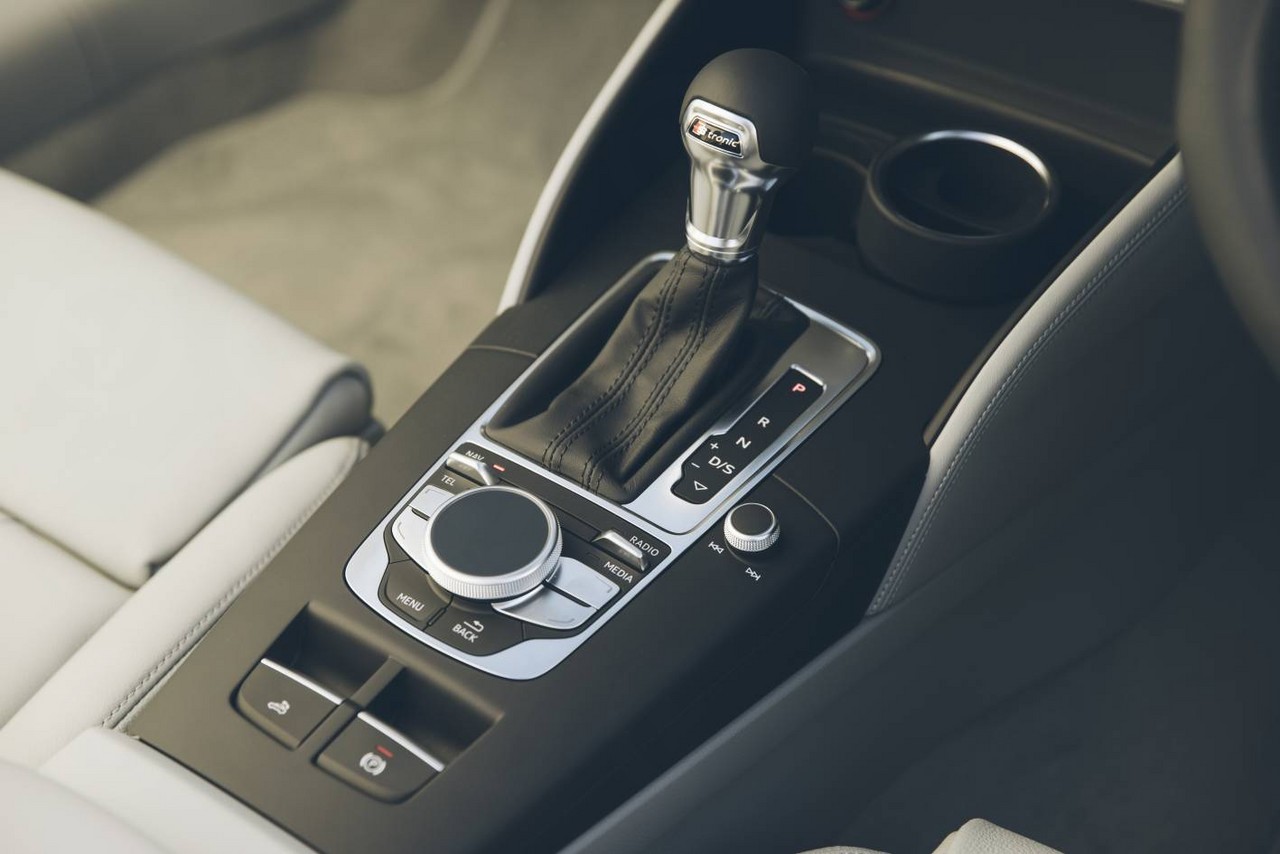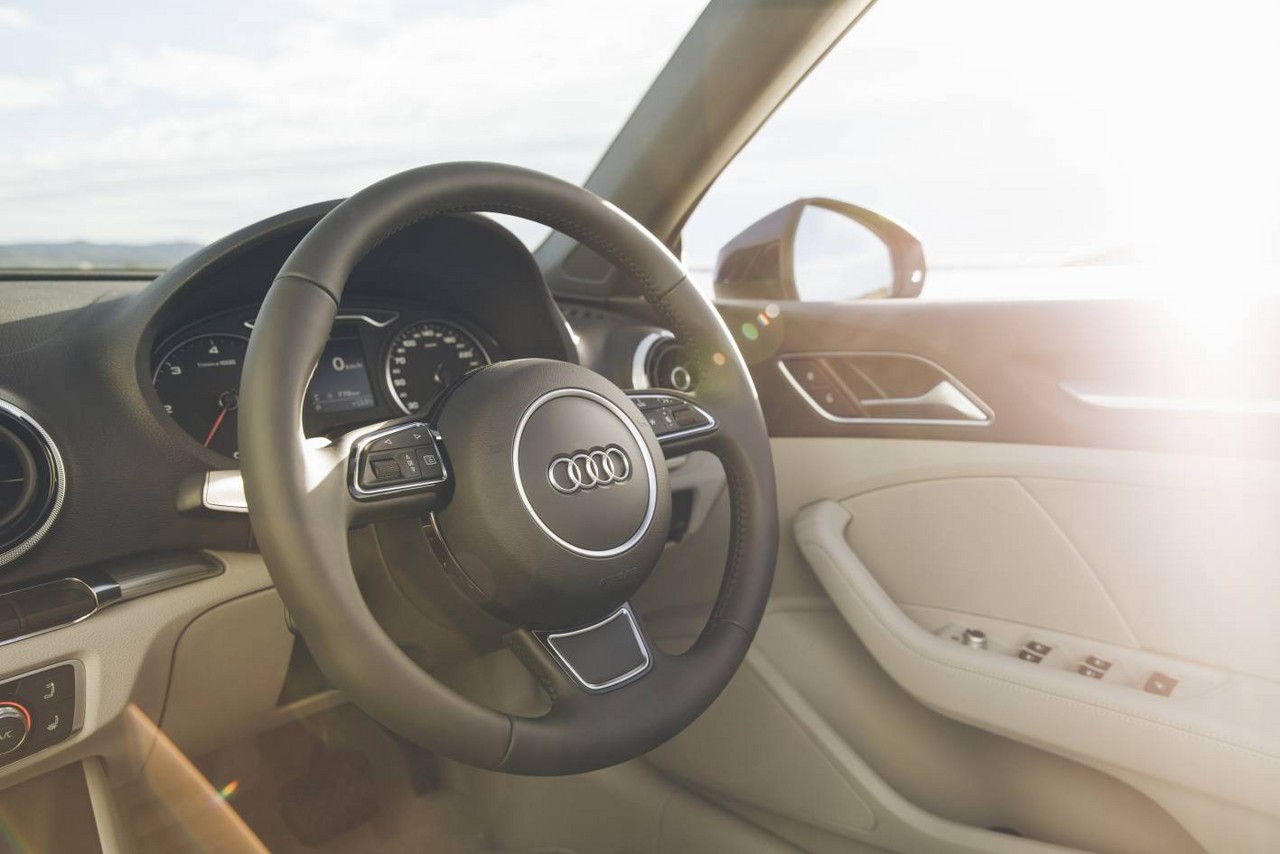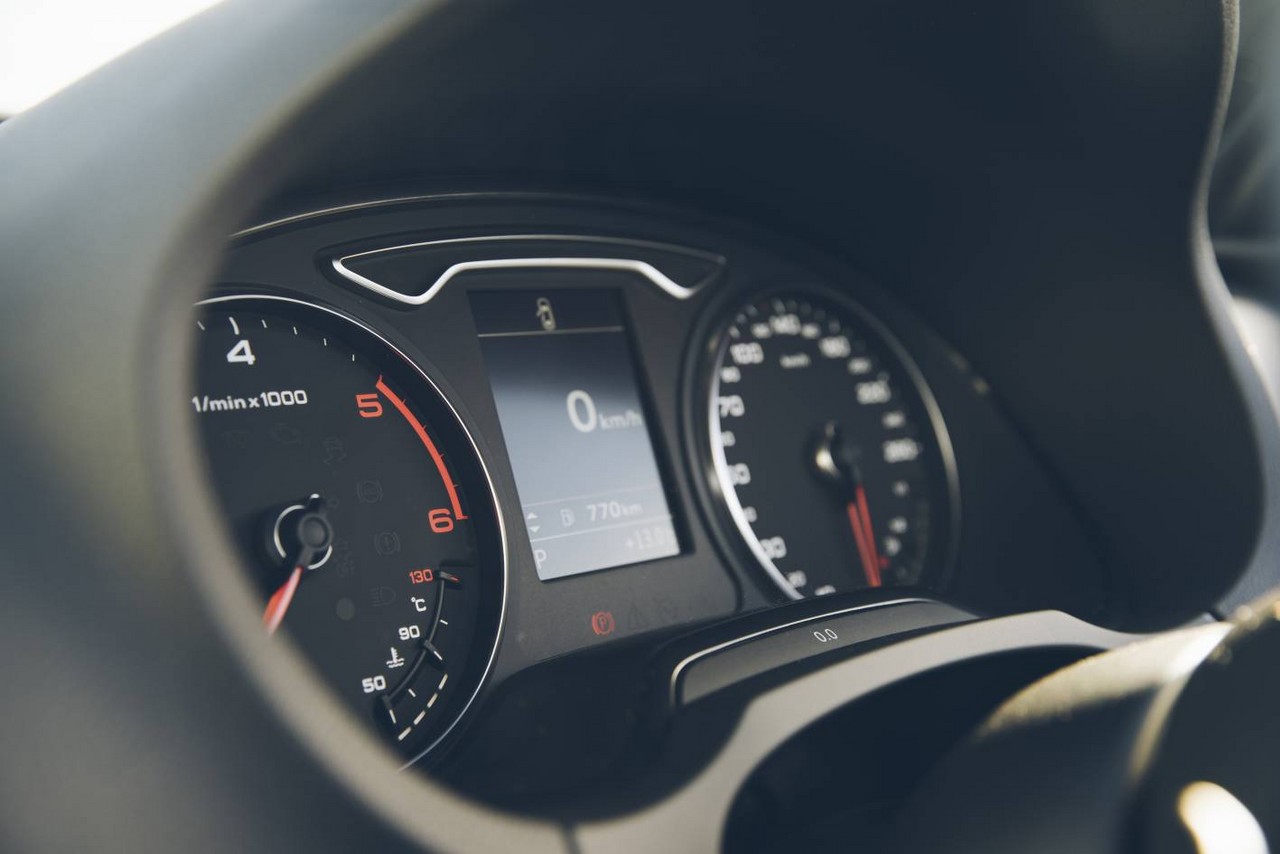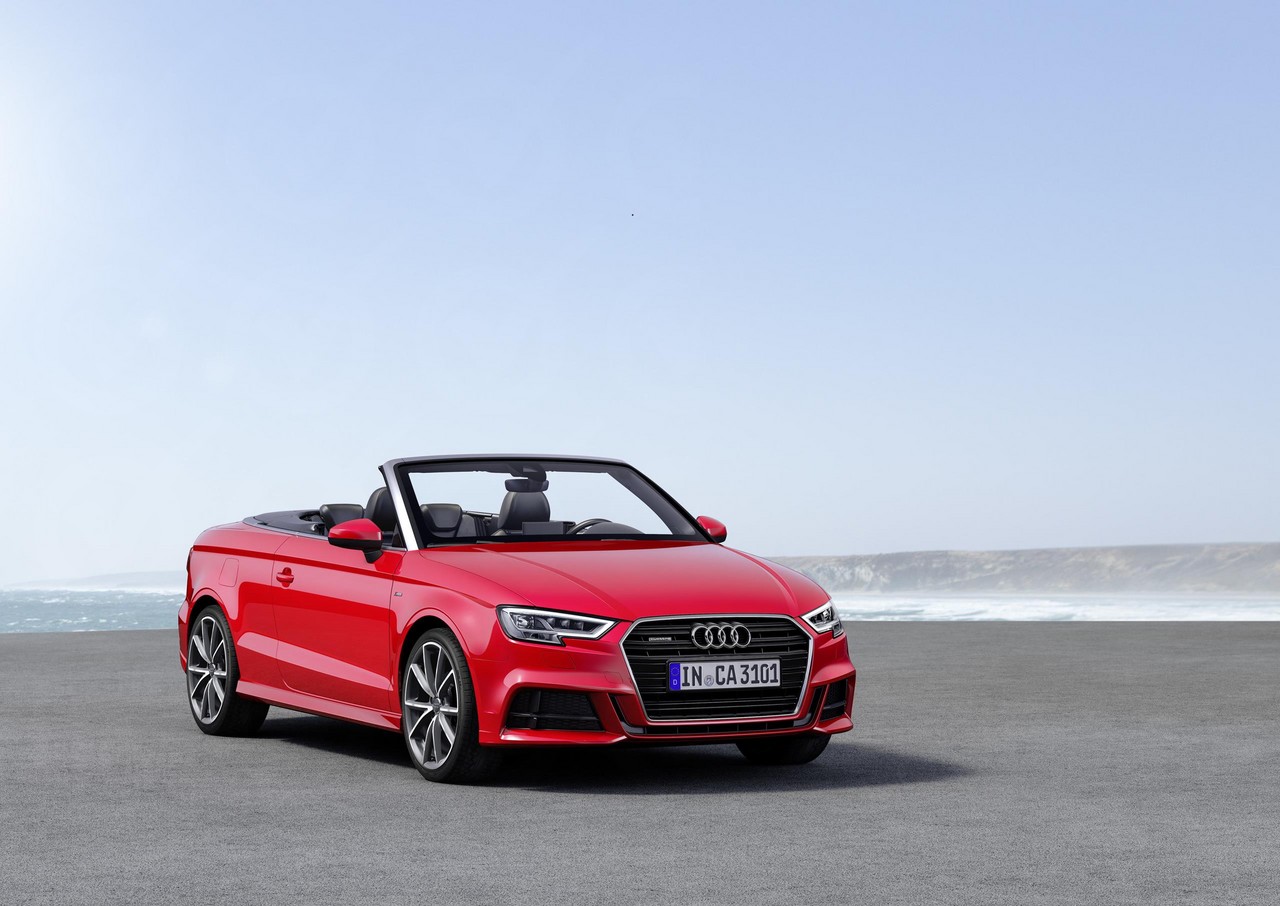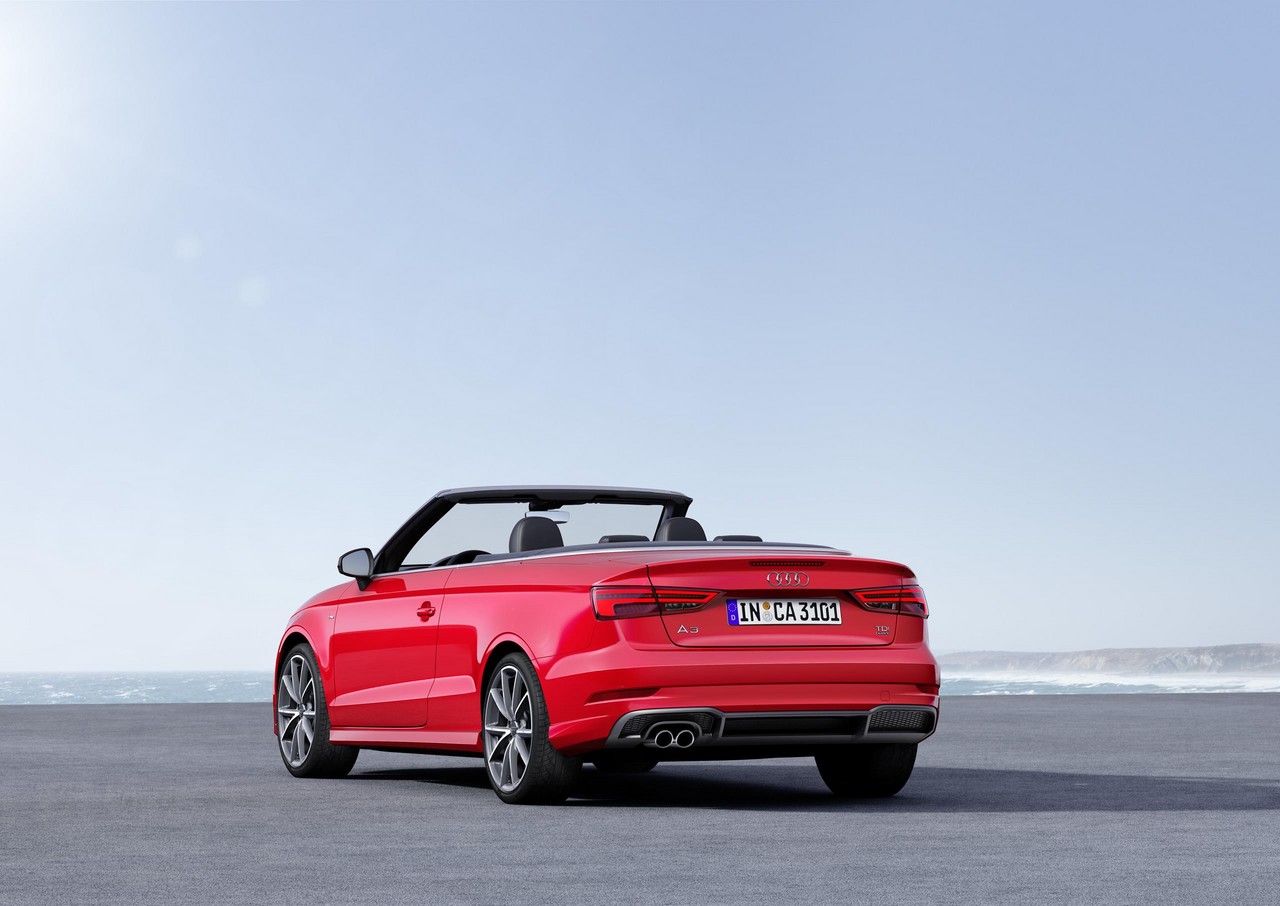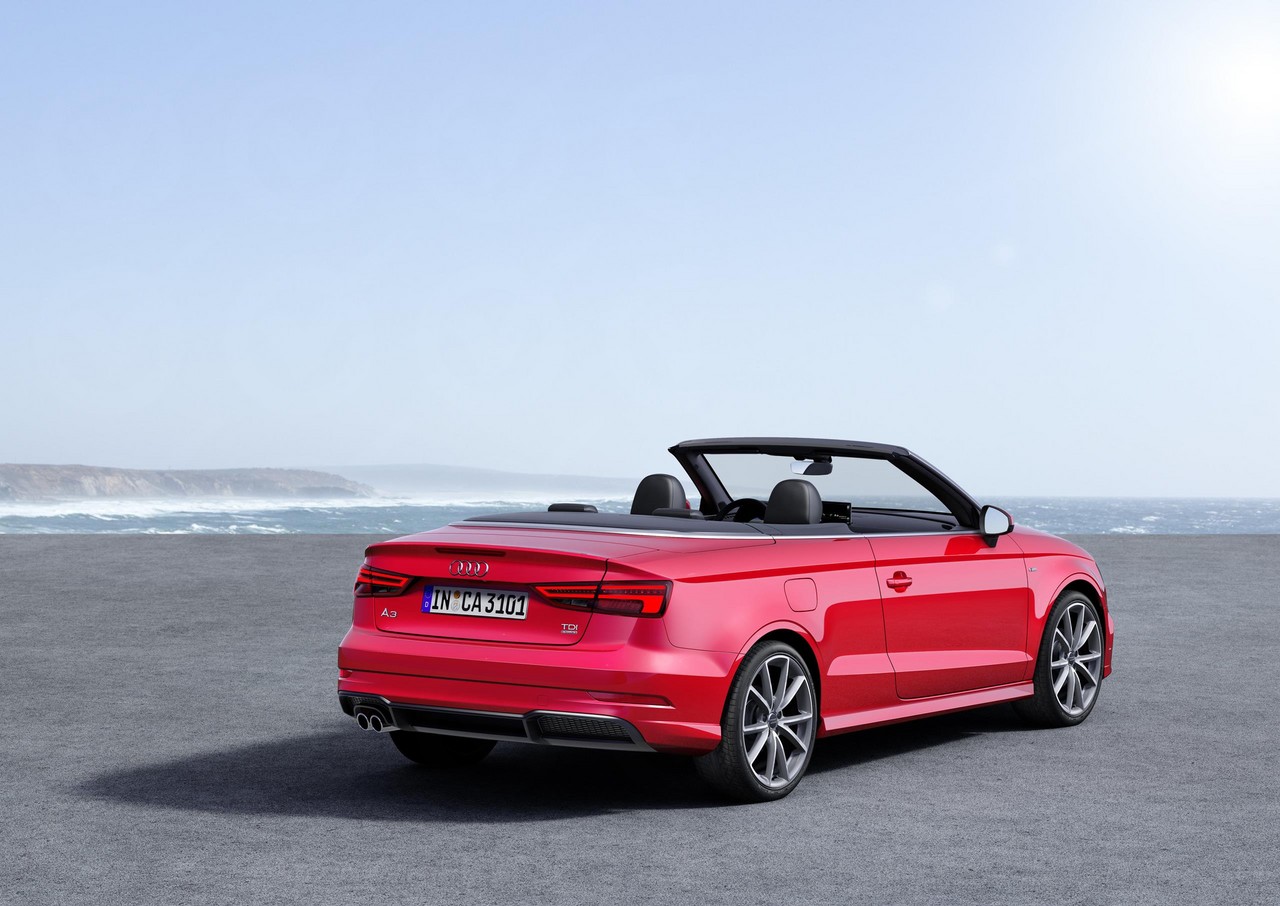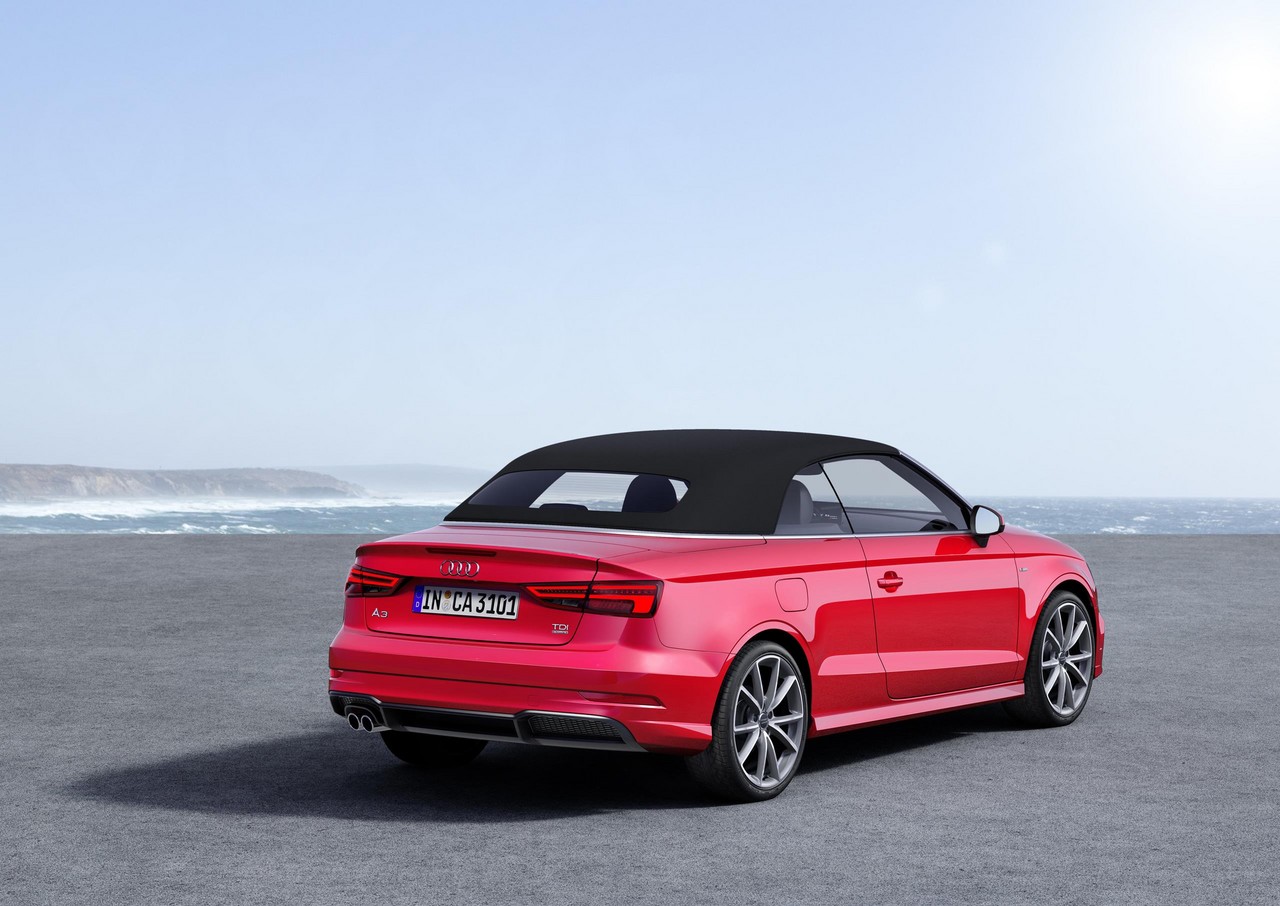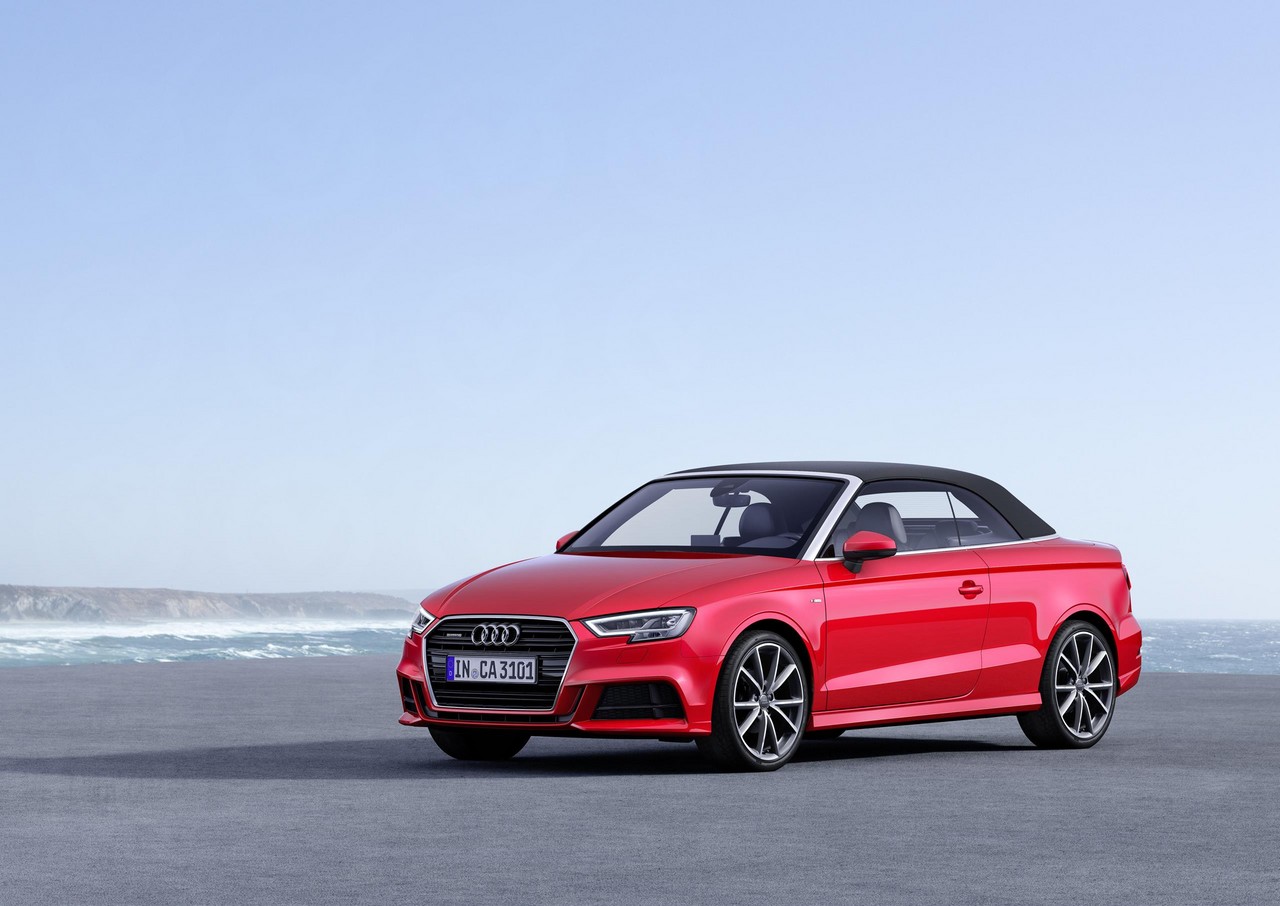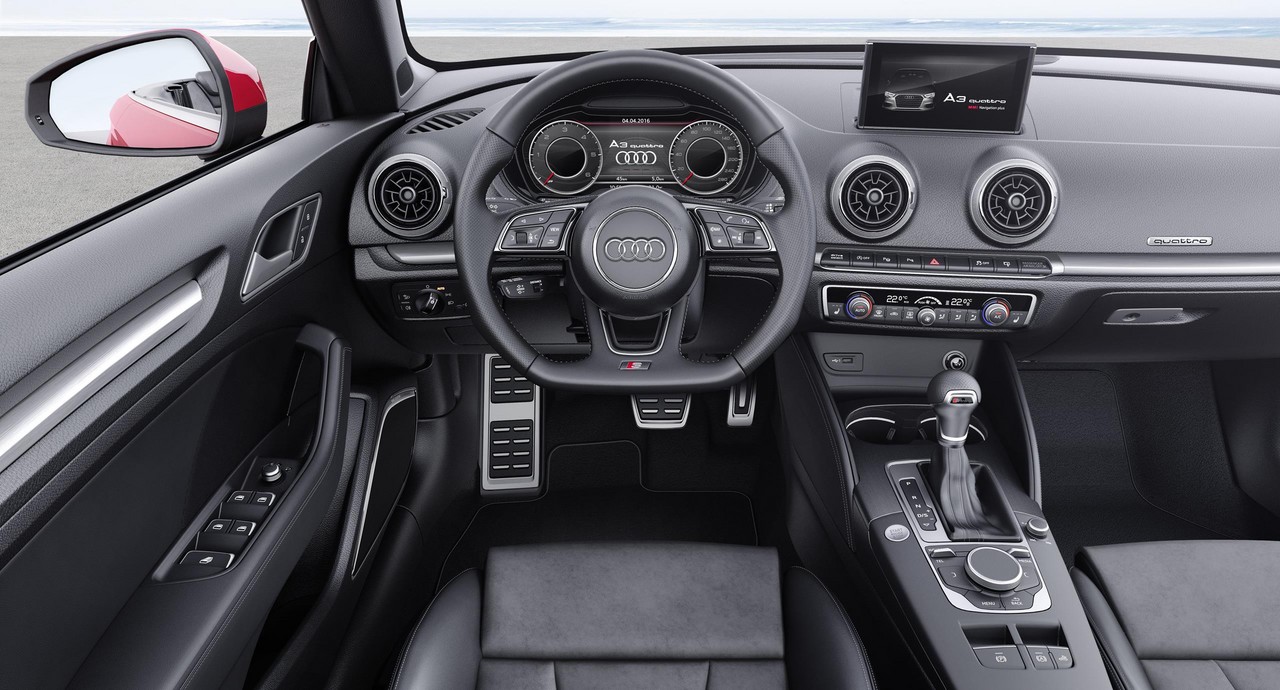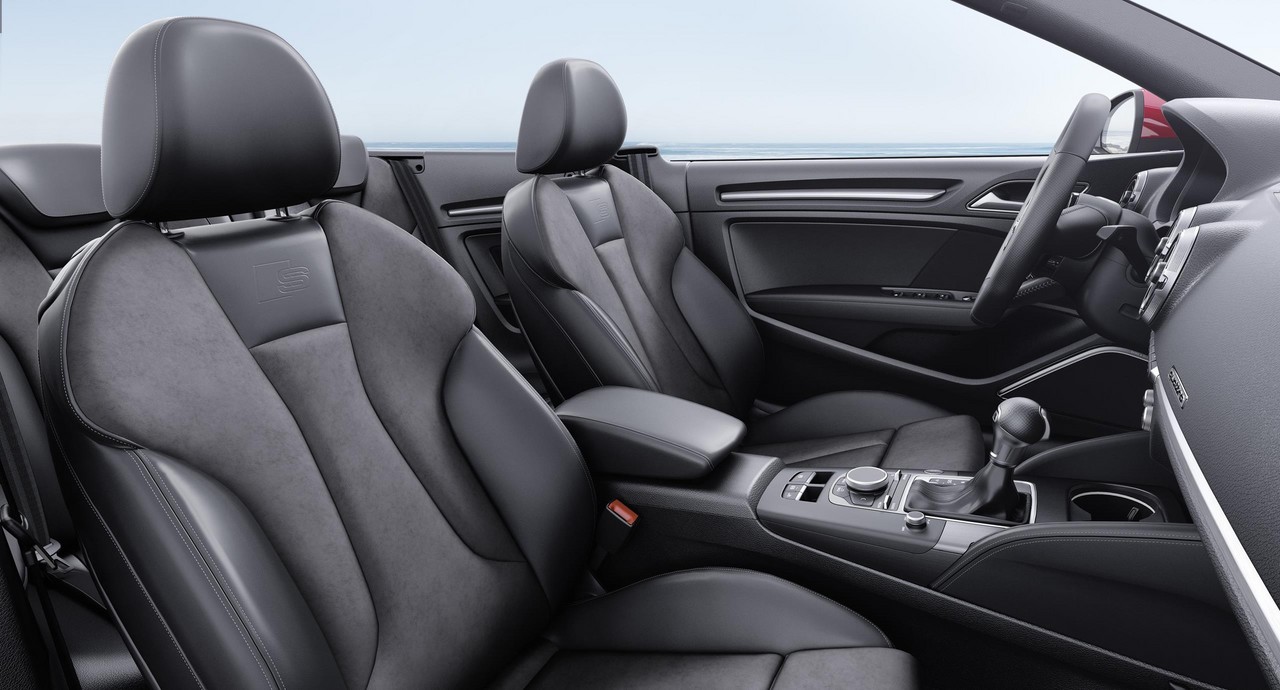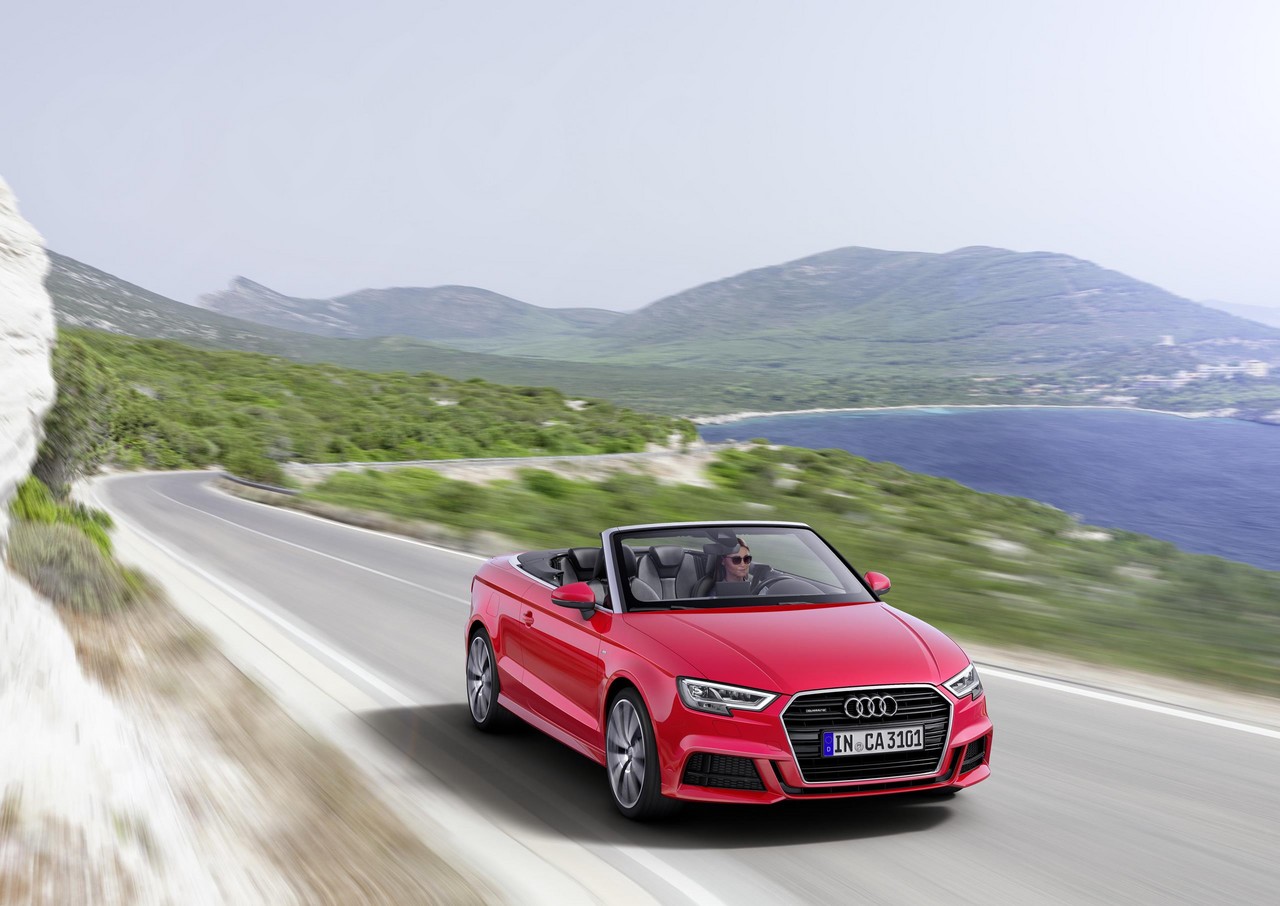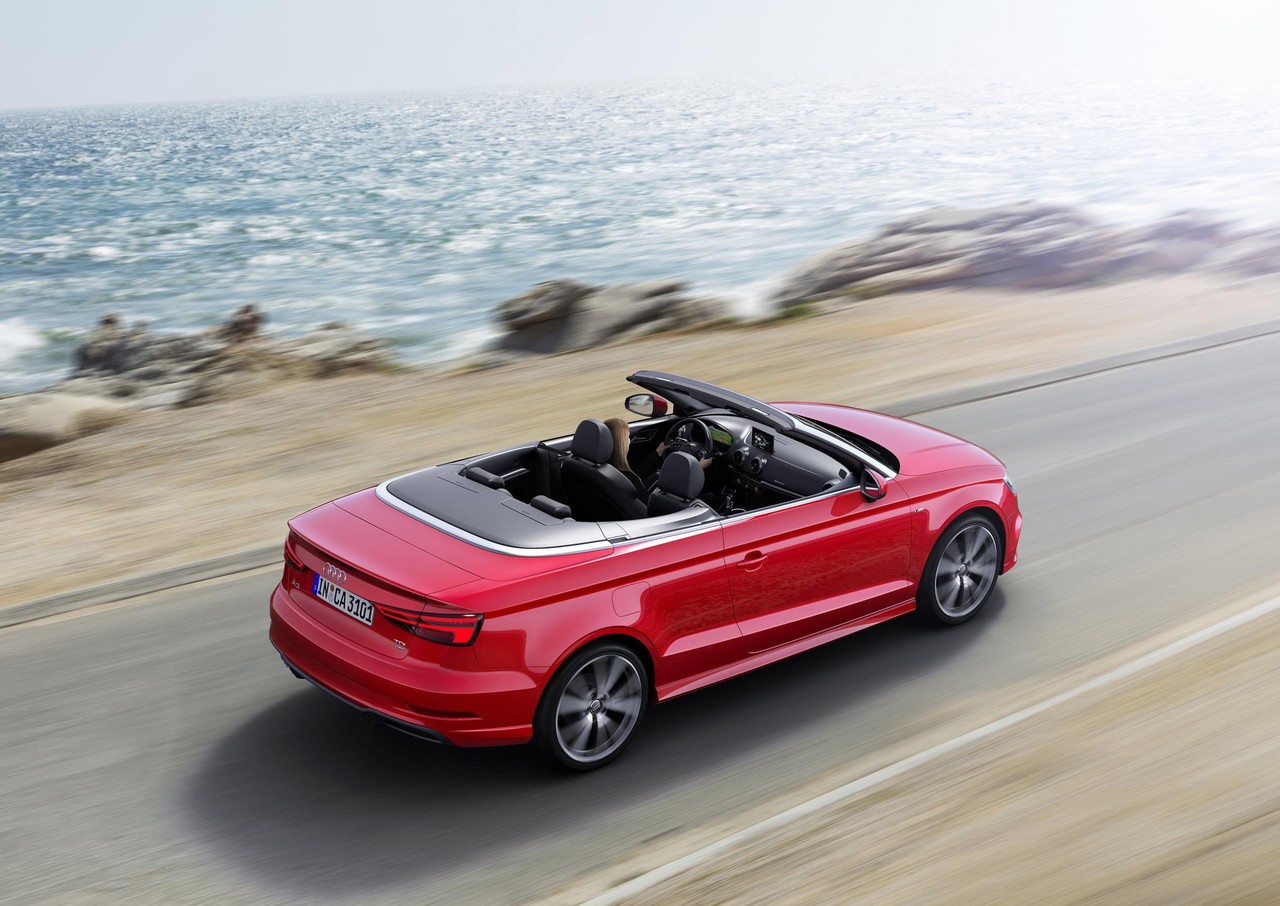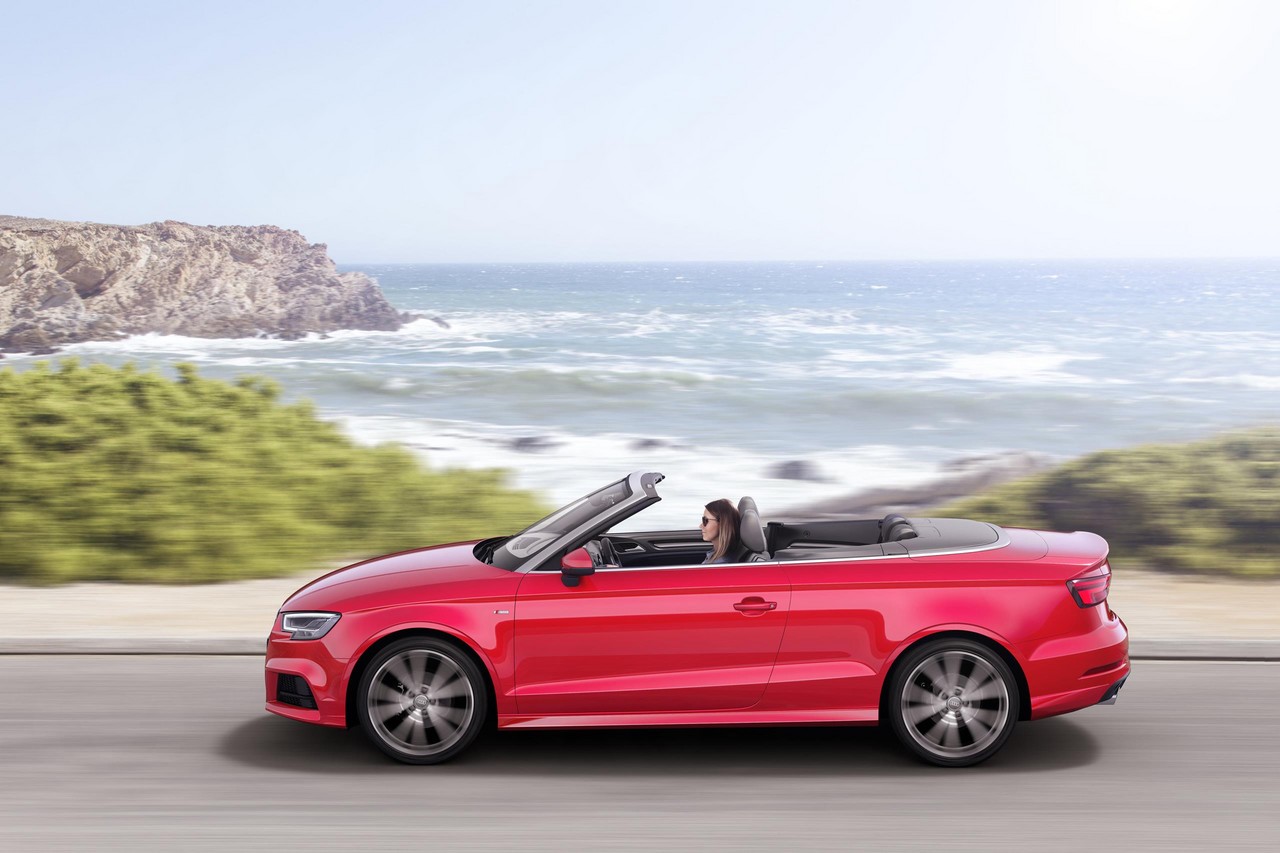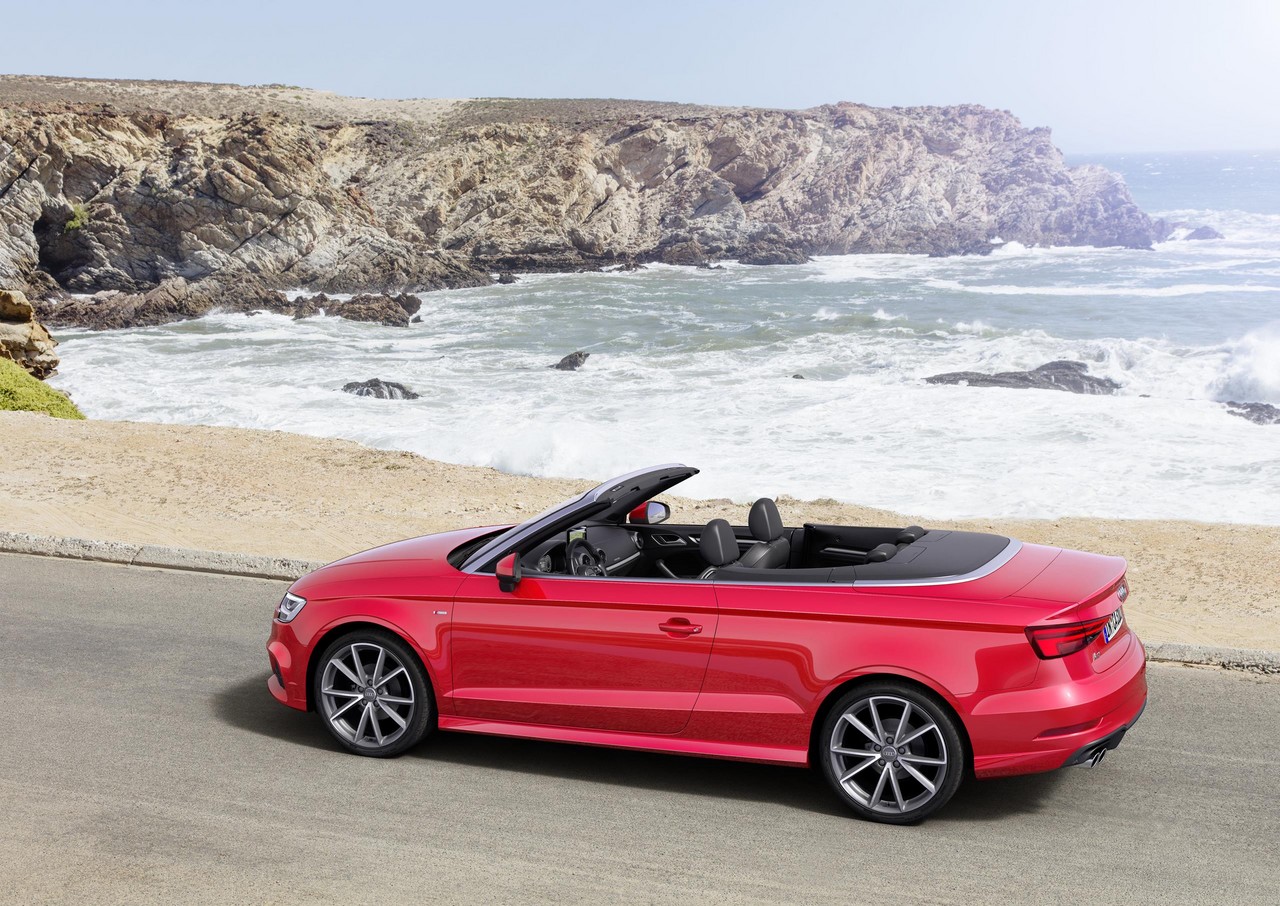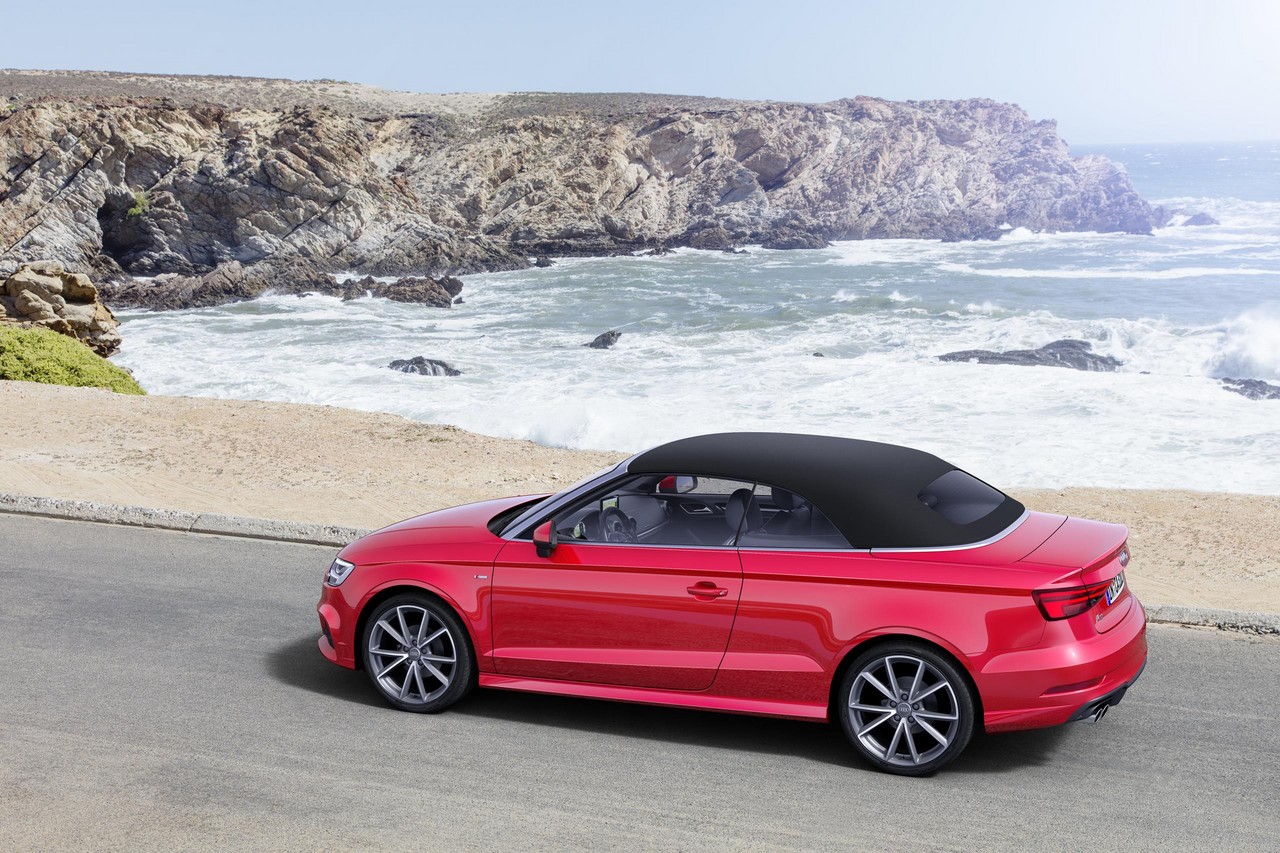
- High standard of interior fit and finish
- Body feels solid
- Refined
- Poor rear seat space
- Limited boot space
Review: Audi 8V7.I A3 Cabriolet (2014-16)
Overview
Released in Australia in July 2014, the Audi 8V7 A3 Cabriolet was a two-door convertible with a soft-top roof. Manufactured in Gyor, Hungary, the Audi A3 Cabriolet range consisted of 1.4 TFSI CoD, 1.8 TFSI and 2.0 TDI variants, available in Attraction and Ambition editions (see table below).
Of these variants, all engines had direct fuel injection and Audi’s start-stop system which enabled the engine to shut down when the vehicle was stationary in traffic. Furthermore, the 1.4 TFSI CoD engine could shut down two engine cylinders under low load and coasting conditions to further minimise fuel consumption. All variants had double clutch transmissions (Audi’s ‘S-Tronic’).
| Variant | Edition | Engine | Trans. | Peak power | Peak torque | Years |
|---|---|---|---|---|---|---|
| 1.4 TFSI CoD | Attraction | 1.4-litre CPTA/CZEA turbo petrol I4 | 7sp DCT | 103 kW at 5000 rpm | 250 Nm at 1500-3500 rpm | 2013-14 |
| 1.4-litre turbo petrol I4 | 7sp DCT | 110 kW at 5000-6000 rpm | 250 Nm at 1500-3500 rpm | 2014-16 | ||
| 1.8 TFSI | Ambition | 1.8-litre CJSA turbo petrol I4 | 7sp DCT | 132 kW at 5100-6200 rpm | 250 Nm at 1250-5000 rpm | 2013-16 |
| 1.8 TFSI quattro | Ambition | 1.8-litre CJSA turbo petrol I4 | 6sp DCT | 132 kW at 4500-6200 rpm | 280 Nm at 1350-4500 rpm | 2013-16 |
| 2.0 TDI | Ambition | 2.0-litre CRBC/CRLB turbo-diesel I4 | 6sp DCT | 110 kW at 3500-4000 rpm | 320 Nm at 1750-3000 rpm | 2013-16 |
Body and soft-top roof
Compared to the Audi 8P A3 Cabriolet , the 8V7 A3 Cabriolet was 138 mm longer (at 4421 mm), 28 mm wider (1793 mm), 40 mm taller (1409 mm) and had a 17 mm longer wheelbase (2595 mm); its drag coefficient was 0.30 Cd.
The Audi 8V7 A3 Cabriolet had a power-operated soft-top roof – with a glass rear window – which could open or close in less than 18 seconds and could be operated while travelling at speeds of up to 50 km/h. When retracted, the roof folded into three layers and rested on a tray within the boot – in this position, boot capacity was 287 litres.
Steering and suspension
The Audi 8V7 A3 Cabriolet had electromechanical speed-sensitive steering, MacPherson strut front suspension and independent, four-link rear suspension.
All-wheel drive (quattro)
For the A3 Cabriolet 1.8 TFSI, the all-wheel drive system (Audi’s ‘quattro’) utilised a newly developed multi-plate clutch which was hydraulically actuated and electronically controlled. In normal conditions, drive was directed to the front wheels though, in the event that traction was lost, the multi-plate clutch would engage to direct up to 50 per cent of the engine’s torque to the rear wheels (for a 50:50 front:rear torque split).
Safety equipment
Standard safety equipment for the Audi 8V7 A3 Cabriolet included dual front airbags, a driver’s knee airbag, front seat-mounted side airbags, ABS, electronic brake force distribution, brake assist, electronic stability control, traction control and fronts seatbelts with pre-tensioners and load limiters.
The A3 Cabriolet was also available with the following optional (extra-cost) driver assistance systems –
- Adaptive cruise control (ACC): radar-based cruise control which maintained a preset distance from the car ahead. For models with the S-Tronic transmissions, ACC included a ‘stop & go’ function for low speeds;
- Side assist: a blind spot monitoring system which used a rear-facing radar to monitor traffic for lane changes;
- Active lane assist: helped drivers remain in their lane by making slight steering adjustments via the electromechanical steering system;
- Park assist: could autonomously steer the vehicle into parallel and perpendicular parking spaces (manoeuvring multiple times if necessary) using twelve ultrasonic sensors to provide a 360 degree display
- Pre-sense basic: if the vehicle experienced a loss of traction, the front seatbelts would be tensioned and the windows would be raised;
- Pre-sense front: in the event of a pending front:rear collision with the vehicle ahead, the driver received progressive warnings and the brakes could be activated autonomously. At speeds below 30 km/h, nearly full braking force could be applied (Audi’s ‘City Emergency Braking’); and,
- Multicollision brake assist: automatically applied the brakes after a collision to prevent the vehicle from continuing to roll in an uncontrolled manner.
Features: Audi 8V7 A3 Cabriolet
Standard features for the Audi A3 Cabriolet Attraction included 17-inch alloy wheels, an eight speaker sound system with an eight-inch colour display (Audi’s Multi-Media Interface, MMI), a CD player, MP3/WMA/AAC compatibility, auxiliary inputs (3.5 mm/USB/SDHC card) and Bluetooth connectivity, dual-zone climate control air conditioning, Milano leather upholstery, cruise control, automatic headlights, rain-sensing wipers, rear parking sensors, a leather-wrapped steering wheel with gearshift paddles, folding rear seats, remote central locking, power windows and heated mirrors, tilt and telescopic steering wheel adjustment, an electromechnical parking brake, tyre pressure monitoring, a 12 volt power outlet in the centre console, a trip computer, space-saver spare wheel and an immobiliser.
The A3 Cabriolet Ambition was further equipped with front fog lights, sport front seats, a sport steering wheel, colour driver information system (DIS) display, aluminium interior inlays and aluminium door sill trims. The Ambition editions were also fitted with ‘Audi drive select’ which enabled the driver to select drive modes which varied throttle response, steering weighting, gear shift mapping and enabled the operation of a free-wheeling function that could disengage the drivetrain to prevent engine braking.
Related links
Review: Audi 8V7.II A3 Cabriolet (2016-20)
Overview
Commencing production in May 2016 and officially released in Australia in November 2016, the Audi 8V7 Series II (8V7.II) A3 Cabriolet introduced a revised range as the 1.8 TFSI variants were replaced by 2.0 TFSI variants, and the 2.0 TDI was discontinued.
Visually, the Audi 8V7.II A3 Cabriolet could be identified by its wider single-frame grille with which had sharper contours, flatter headlights (bi-xenon units as standard) with jagged bottom edges and new tail-lights. Inside, there were revised air conditioning vents, while the ‘Audi virtual cockpit’ – which replaced the analogue instrument dials with a 12.3-inch TFT screen – was available as an extra-cost option as part of the Technik package.
Significantly, the Audi 8V7.II A3 Cabriolet was fitted with autonomous emergency braking (AEB) and satellite navigation as standard.
| Variant | Engine | Trans. | Peak power | Peak torque |
|---|---|---|---|---|
| 1.4 TFSI CoD | 1.4-litre CZEA turbo petrol I4 | 7sp DCT | 110 kW at 5000-6000 rpm | 250 Nm at 1500-3500 rpm |
| 2.0 TFSI Sport | 2.0-litre CZPB turbo petrol I4 | 7sp DCT | 140 kW at 4200-6000 rpm | 320 Nm at 1500-4200 rpm |
| 2.0 TFSI quattro S line | 2.0-litre CZPB turbo petrol I4 | 7sp DCT | 140 kW at 4200-6000 rpm | 320 Nm at 1500-4200 rpm |
Safety equipment
For the Audi 8V7.II A3 Cabriolet, standard safety equipment was extended to include –
- Audi pre-sense city with Autonomous Emergency Braking (AEB) and pedestrian detection: operating at speeds up to 85 km/h, Audi pre sense city used a windscreen-mounted front camera to scan the road for other vehicles and pedestrians. If there was a risk of a collision, the driver would receive a series of warnings and, if the driver failed to respond, full braking force would be applied autonomously. At initial speeds of up to 40 km/h, collisions can be prevented; at higher speeds (up to 85 km/h), the severity of the collision would be reduced;
- Audi pre sense basic: in the event that a collision was anticipated, pre sense basic initiated occupant protection measures such as electric tensioning of the seatbelts and closing of the windows and sunroof (where fitted); and,
- Attention assist: monitored driver behaviour for signs of inattentiveness and would provide a warning tone and visual signal if detected.
Beyond this, the A3 Cabriolet 2.0 TFSI Sport and 2.0 TFSI quattro S line models were also equipped with –
- Audi side assist: operating at speeds above 15 km/h, Audi side assist used the two rear radar sensors to monitor traffic up to 70 metres behind the Audi A3 Cabriolet. If another vehicle approached quickly or was in the driver’s blind spot, a warning LED in the housing of the appropriate door mirror would illuminate. If the driver activated the indicator to change lanes, the LED would blink rapidly to warn the driver; and,
- Cross traffic assist rear: when reversing at low speeds, rear cross-traffic assist used the rear radar sensors to detect approaching traffic. If approaching traffic was detected which may cross the vehicle’s path, the driver received warnings (visual, acoustic and a brief, jolting application of the brakes).
Assistance package
As an extra-cost option, the Audi 8V7.II A3 Cabriolet could be specified with an ‘Assistance package’ which included –
- Adaptive Cruise Control (ACC): using two front radar sensors and the camera, ACC could maintain a specified distance – from five distances – between the A3 Cabriolet and the vehicle ahead. Furthermore, ‘Audi drive select’ could be used to adjust the rate of acceleration and other control dynamics;
- Stop&Go function: an extension of ACC, ‘Stop&Go’ operated at speeds of 60 km/h to apply the brakes and bring the vehicle to rest. Once traffic began moving, the Audi S4 would automatically accelerate;
- Traffic-jam assist: another extension of the ACC, the traffic-jam assist function could take control of steering operations at speeds up to 65 km/h on ‘well-developed roads when traffic is congested.’ In doing so, traffic-jam assist used the lane markings and other vehicles on the road for orientation. When the traffic-jam assist function reached its limits – for example, when traffic is sparse or there is a sharp corner ahead – the driver had to take over steering. Hence, the system provided warnings at different levels;
- Audi pre-sense front: scanned the road for vehicles when travelling at speeds up to 200 km/h and for pedestrians when travelling at speeds of up to 65 km/h. If there was a risk of collision, the driver would be warned and partial braking would be initiated automatically. If the collision risk persisted, full braking could be initiated (i.e. autonomous emergency braking or AEB);
- High beam assist: automatically switched between low and high beam headlights for improved visibility, using a sensor to determine when it was safe to do so (i.e. without dazzling other drivers);
- Audi active lane assist: operating at speeds of 65 km/h and above, Audi active lane assist used the front camera to recognise lane markings. As the vehicle approached a lane marking without the turn signal having been activated, the system provided a slight steering intervention to direct the vehicle back into its lane. Through the MMI system, the driver could select whether this intervention occurred at an early stage (in which case the vehicle was steered to the centre of its lane) or only shortly before crossing the line. The steering wheel could also vibrate as a warning signal if selected;
- Audi side assist (see above);
- Cross traffic assist rear (see above); and,
- Hold assist: would automatically apply the brakes when the vehicle was stationary to prevent it from rolling as the driver moved their foot from the brake to the accelerator.
Features: Audi 8V7.II A3 Cabriolet
Compared to the Audi 8V7.I A3 Cabriolet Attraction, standard features for the Audi 8V7.II A3 Sedan 1.4 TFSI CoD were extended to include Audi’s MMI navigation with a seven-inch high resolution colour display, CD player, SDHC memory card reader, integrated voice control and eight speakers, xenon headlights with LED daytime running lights, illuminated vanity mirrors and floor mats. The A3 Sedan 1.4 TFSI CoD was also equipped with the ‘Audi parking system plus’ which consisted of parking sensors (front and rear) and a rear view camera.
Compared to the 1.4 TFSI CoD, the A3 Cabriolet 2.0 TFSI Sport added front sports seats, aluminium door sill trims and the ‘Audi smartphone interface’ which provided Apple CarPlay and Android Auto smartphone integration via the USB port. The A3 Cabriolet 2.0 TFSI Sport and 2.0 TFSI quattro S line were also fitted with ‘Audi drive select’ which enabled the driver to select from five drive modes which adjusted accelerator pedal response, transmission behaviour and air conditioning output.
The A3 Cabriolet 2.0 TFSI quattro S line was distinguished by its 18-inch alloy wheels with 225/40 R18 tyres, 15 mm lower sports suspension, LED headlights with washers and LED tail-lights.
Matrix LED headlights
As an extra-cost option, the Audi 8V7.II A3 Cabriolet could be specified with ‘Matrix LED’ headlights which used fifteen LEDs each produce a high beam that radiated from three reflectors. Using information from the forward-facing camera, their control module could turn them on or off individually, or dim them in 64 stages.
Related links
- Specifications: Audi 8V7.II A3 Cabriolet (November 2016)
- Audi Australia: Audi A3 Cabriolet
- Wikipedia.org: Audi A3
